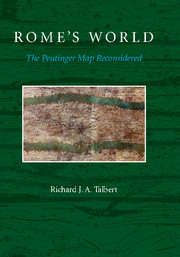Book contents
- Frontmatter
- Contents
- List of Plates, Figures, and Table
- Preface and Acknowledgments
- Abbreviations
- INTRODUCTION
- 1 THE SURVIVING COPY: HISTORY, PUBLICATION, SCHOLARSHIP
- 2 THE SURVIVING COPY: THE MATERIAL OBJECT AND ITS PALEOGRAPHY
- 3 THE DESIGN AND CHARACTER OF THE MAP
- 4 RECOVERY OF THE ORIGINAL MAP FROM THE SURVIVING COPY
- 5 THE ORIGINAL MAP
- CONCLUSION: THE MAP'S PLACE IN CLASSICAL AND MEDIEVAL CARTOGRAPHY
- APPENDIX 1 Latin Text Appended to the 1598 Engraving of the Map
- APPENDIX 2 English Translation of J. Kastelic, “Vodnikova kopija Tabule Peutingeriane” (trans. Gerald Stone)
- APPENDIX 3 Reflections on Vodnik's Copy of von Scheyb's Engraving
- APPENDIX 4 Vodnik's Latin Summary of Heyrenbach's Essay (National Library of Slovenia, Ljubljana, MS 1443)
- APPENDIX 5 Miller's Reconstruction of the Map's Western End
- APPENDIX 6 Wyttenbach's Claim: A Lost Piece of the Map Discovered
- APPENDIX 7 User's Guide to the Database and Commentary
- APPENDIX 8 User's Guide to the Map (A) and Overlaid Layers
- APPENDIX 9 User's Guide to the Outlining of Rivers and Routes on Barrington Atlas Bases (C–F), with Associated Texts: (a) Antonine Itinerary (ItAnt) Text with Journeys Numbered as on Map E, and (b) Bordeaux Itinerary (ItBurd) Text with Journeys Lettered as on Map F
- Notes
- Bibliography
- Index and Gazetteer
Preface and Acknowledgments
- Frontmatter
- Contents
- List of Plates, Figures, and Table
- Preface and Acknowledgments
- Abbreviations
- INTRODUCTION
- 1 THE SURVIVING COPY: HISTORY, PUBLICATION, SCHOLARSHIP
- 2 THE SURVIVING COPY: THE MATERIAL OBJECT AND ITS PALEOGRAPHY
- 3 THE DESIGN AND CHARACTER OF THE MAP
- 4 RECOVERY OF THE ORIGINAL MAP FROM THE SURVIVING COPY
- 5 THE ORIGINAL MAP
- CONCLUSION: THE MAP'S PLACE IN CLASSICAL AND MEDIEVAL CARTOGRAPHY
- APPENDIX 1 Latin Text Appended to the 1598 Engraving of the Map
- APPENDIX 2 English Translation of J. Kastelic, “Vodnikova kopija Tabule Peutingeriane” (trans. Gerald Stone)
- APPENDIX 3 Reflections on Vodnik's Copy of von Scheyb's Engraving
- APPENDIX 4 Vodnik's Latin Summary of Heyrenbach's Essay (National Library of Slovenia, Ljubljana, MS 1443)
- APPENDIX 5 Miller's Reconstruction of the Map's Western End
- APPENDIX 6 Wyttenbach's Claim: A Lost Piece of the Map Discovered
- APPENDIX 7 User's Guide to the Database and Commentary
- APPENDIX 8 User's Guide to the Map (A) and Overlaid Layers
- APPENDIX 9 User's Guide to the Outlining of Rivers and Routes on Barrington Atlas Bases (C–F), with Associated Texts: (a) Antonine Itinerary (ItAnt) Text with Journeys Numbered as on Map E, and (b) Bordeaux Itinerary (ItBurd) Text with Journeys Lettered as on Map F
- Notes
- Bibliography
- Index and Gazetteer
Summary
Experience and accident mixed with frustration and optimism have combined to launch this study. I probably read about its object first in one of my schoolbooks, the 1961 revision of Everyman's Classical Atlas introduced by J. Oliver Thomson (“As a map this ribbon is absurd, but its aim is only to give roads with their stations …”), and over time I grew accustomed to the illustrations of one segment or another seen in publications of all kinds about Roman history and culture. Once I became seriously engaged with cartography from the 1980s, my awareness of the importance of the Peutinger “Table” or Map sharpened correspondingly. As the Barrington Atlas took shape during the 1990s, I witnessed at first hand the heavy dependence that many contributors laid upon this “absurd” survival for place-names and routes across the entire Roman world. At the same time, when I ventured into the emerging debate about Romans' “map consciousness” or the lack of it, colleagues' widespread preference for excluding this item from consideration on the grounds that it should be viewed as a diagram rather than a map came to seem less and less justifiable. I was for a long time incredulous that no full-scale presentation and analysis of it had appeared since World War I. Although color photographs had eventually been published in 1976, many scholars had still not abandoned their reliance upon the more accessible nineteenthcentury lithographed drawings.
- Type
- Chapter
- Information
- Rome's WorldThe Peutinger Map Reconsidered, pp. xiii - xviPublisher: Cambridge University PressPrint publication year: 2010



